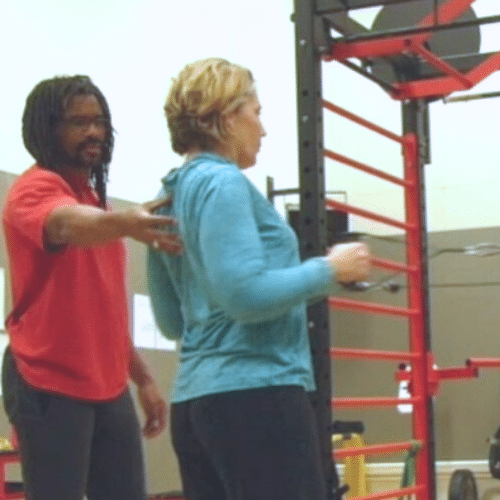Back stretching with 1 extended arm
Technique :
You are standing with your feet hip-width apart. First of all, you will slightly bend your knees. Follow with a retroversion of the pelvis by simultaneously contracting your abs and buttocks.
With a contracted hollow belly and abdominal muscles, perform a facial or lateral elevation of one arm to bring it close to your ear ( the arm is vertical). Then with the other hand, you will grab the elbow of the outstretched arm and pull slightly on it (your chest will lean to the side, of course).
Make sure to keep your back straight all along the stretch.
To do a good stretch, you will have to respect these rules:
- Remember to breathe continuously ( Deep breathing cycle of inhalation and exhalation)
- Never block your breathing when stretching.
- Do your stretching for at least 30 seconds
- Stretching will always be done gradually. So that your muscles can get used to this type of work.
Stretched muscles:
Main muscles: Large dorsal, large round, lumbar, spinal, spinal, trapezius
Secondary muscles :
Role of the back:
Support and protection role. The spine gives the back a role in supporting the head and protecting the spinal cord.
Role in mobility and posture. All the components of the back preserve the posture of the trunk and thus maintain the standing position. The structure of the back allows many movements such as trunk twisting, trunk bending or pulling movements.
Variant of the exercise:
In the same position, instead of keeping your legs parallel, you can cross one foot over the other. For example, if you have the right arm stretched, cross the right one over the left. This variation is very interesting, because it allows you to stretch the entire side chain
Possible back pathology:
Back pain is defined as localized pain that most often originates in the spine and usually affects the surrounding muscle groups. Depending on their origin, three main forms are distinguished: neck pain, back pain and low back pain.
Sciatica, characterized by pain starting from the lower back and extending into the leg. They are frequent and are due to compression of the sciatic nerve. Different pathologies can be at the origin of these pains.
- Different pathologies can lead to the progressive degradation of cellular elements. Osteoarthritis is characterized by wear and tear of the cartilage protecting the bones of the joints. Disc herniation is the expulsion of the intervertebral disc from the back of the nucleus by wear and tear.This can result in compression of the spinal cord or sciatic nerve.
- Different deformations of the column may appear. Scoliosis is a lateral displacement of the spine. Kyphosis develops with excessive back curvature at shoulder height, while lordosis is associated with increased lumbar arch.
- Lumbago and stiff neck. These pathologies are due to deformities or tears in the ligaments or muscles, located respectively in the lumbar region or in the cervical region.

